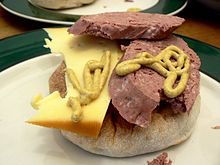Braunschweiger (sausage)
This article needs additional citations for verification. (February 2013) |
 Braunschweiger Mettwurst | |
| Type | Sausage |
|---|---|
| Place of origin | Germany |
| Region or state | Braunschweig |
| Main ingredients | Pork |
| Variations | Braunschweiger liverwurst |
Braunschweiger (named after Braunschweig, Germany) is the name for several types of sausages in different regions. In Germany, the Braunschweiger literally means "person or thing from Braunschweig", but usually refers to a variety of Mettwurst. In Austria, Braunschweiger is known as a type of Brühwurst, while American Braunschweiger is a type of liverwurst.[1]
In Germany
Braunschweiger Mettwurst is a smoked, soft and spreadable sausage made from raw minced pork.[1]
In Austria
In Austria Braunschweiger a variant which is similar to the Brühwurst is known, or Jagdwurst (Hunter sausage). Made with a mixture of pork and beef, Speck and nitrites. This type of sausage is usually eaten between meals.
In the United States

In the United States, Braunschweiger refers to a type of liverwurst (pork liver sausage) which, if stuffed in natural casings, is nearly always smoked. Commercial products often contain smoked bacon, and are stuffed into fibrous casings.
The USDA requires that the product contain a minimum of 30% liver.[2] A typical commercial formula is about 40% pork liver or scalded beef liver, 30% scalded pork jowl, 20% lean pork trimmings and 10% bacon ends and pieces. Added seasonings include salt and often include white pepper, onion powder or chopped onion, and mace. Curing ingredients (sodium erythorbate and sodium nitrite) are optional.
Braunschweiger has a very high amount of vitamin A, iron, protein and fat. The meat has a very soft, spread-like texture and a distinctive spicy liver-based flavor, very similar to the Nordic leverpostej. It is usually used as a spread for toast, but can also be used as a filling for sandwiches, often paired with stone-ground mustard, sliced tomato, onion and cheese. In the Midwestern United States, braunschweiger is typically enjoyed in a sandwich with various condiments such as ketchup, mustard, and dill pickles, or simply spread on crackers. There are also a few recipes for pâté and cheese balls which use braunschweiger as a primary ingredient. Pâté is creamier than braunschweiger.
See also
References
- ^ a b "Braunschweiger Wurst" (in German). braunschweig.de. Retrieved 2 April 2015.
- ^ Code of Federal Regulations 9 CFR 319.182 http://edocket.access.gpo.gov/cfr_2009/janqtr/pdf/9cfr319.182.pdf Retrieved 29 June 2010

